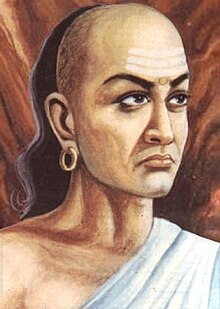Chanakya

Chanakya (IAST: Cāṇakya; c. 350-283 BCE) was an adviser and a prime minister to Chandragupta Maurya (c. 340-293 BCE). He was born in Taxila, Gandhara in modern-day Pakistan.[1] Chanakya helped Chandragupta create the Maurya Empire.[2]
Chanakya's Teachings[change | change source]
Shloka 1- नात्यन्तं सरलैर्भाव्यं गत्वा पश्य वनस्थलीम् ।छिद्यन्ते सरलास्तत्र कुब्जास्तिष्ठन्ति पादपाः ॥
English- Do not be very upright in your dealings, as you would see in forest, the straight trees are cut down while the crooked ones are left standing.
Shloka 2- कः कालः कानि मित्राणि को देशः कौ व्ययागमौ ।कश्चाहं का च मे शक्तिरिति चिन्त्यं मुहुर्मुहुः ॥
English- Consider again and again the following: the right time, the right friends, the right place, the right means of income, the right ways of spending, and from whom you derive your power.
Shloka 3- यो ध्रुवाणि परित्यज्य अध्रुवं परिषेवते ।ध्रुवाणि तस्य नश्यन्ति चाध्रुवं नष्टमेव हि ॥ ०१-१३
English- He who gives up what is imperishable for that which is perishable, loses that which is imperishable; and doubtlessly loses that which is perishable also.
Shloka 4- गुणैरुत्तमतां याति नोच्चैरासनसंस्थितः। प्रासादशिखरस्थोऽपि काकः किं गरुडायते॥ १६-०६
English- Greatness comes from good qualities and not from a high position. A crow doesn’t become a Garuda (the chief of the feathered race) just by sitting on the top of a palace.
Shloka 5- अतिरुपेनावे सिता: अतिगर्वेना उर्वशि अतिदानथा कर्ण पुरुश-श्रेष्ठ निष्पाप सरसवति नारद याति बखान| स्वर्गारोहन परिषेवते सम्राट| अत:पुरुषोत्तम रघुराम, अनाघ याति अयोध्या मे रामराज्य|
English- There can be no beautiful and compassionate woman like Sita. There can be no beautiful but proudy woman like Urvashi. [citation needed]There can be no man like Karna, the supremest of all men(पुरुश-श्रेष्ठ).[citation needed]
His glories and heroism has been narrated by Narada and Saraswati and eventually he attains the highest goal of a human and unites with his brothers in heaven and becomes the king of the Swarga. There can be no great men like Rama, the purushottam himself. He is sinless and eventually he also becomes the king of Ayodhya and brings Ram-Rajya on earth.
Shloka 6- नोच्चैरासनसंस्थितः ज्ञान अत:अहंकार बाली, अत: ज्ञान कृष्ण काकः लंकेश, समाज करे बखान|
English- Knowledge is the most powerful tool in this world. Gyaanis are always respected in this world no matter what. Despite their clans were destroyed, Bali, Krishna and Ravana still have their names in this world because of their 'Gyaan'.
Identity[change | change source]
He is generally called Chanakya (taken from his father's name "Chanak")[3] but, in his capacity as author of the Arthaśhāstra, is generally referred to as Kautilya derived from his gotra's name "KOTIL"(Kautilya means "of Kotil"). He believed in four ways: Treating with Equality, Enticement, Punishment or War and Sowing disagreement.[4] The Arthaśhāstra identifies its author by the name Kautilya, except for one verse which refers to him by the name Vishnugupta.[5] One of the earliest Sanskrit literatures to explicitly identify Chanakya with Vishnugupta was Vishnu Sarma's Panchatantra in the 3rd century BC.[6]
Media[change | change source]
- Television series Chanakya is a fictionalized account of the life and times of Chanakya.
- A book has been published in English titled 'Chanakya on Management"{18} in which each of the 216 sutras on raja-neeti has been translated and commented upon. Clearly, the entire system of thought propounded by Chanakya is based on following good ethical principles.
- In his Arthasastra, Chanakya has discussed widely various economic issues. A book written by Ratan Lal Basu & Rajkumar Sen has dealt exhaustively with these economic concepts of Chanakya and their relevance for the modern world.[7]
- Many eminent Kautilya experts from all over the world had discussed various aspects of Kautilya's thought in an International Conference held in 1902 at Oriental Research Institute, Mysore, India to celebrate the Centenary of discovery of the manuscript of the Arthashastra by R. Shamasastry. Most of the papers presented in the Conference have been compiled in an edited volume by Raj Kumar Sen and Ratan Lal Basu.[8]
References[change | change source]
- ↑ Trautmann, Thomas R. (1971). Kauṭilya and the Arthaśāstra: A Statistical Investigation of the Authorship and Evolution of the Text. Brill.
- ↑ "Mauryan Empire". education.nationalgeographic.org. Retrieved 2023-12-21.
- ↑ Trautmann, Thomas R. (1971). Kautilya and the Arthaśhāstra: A Statistical Investigation of the Authorship and Evolution of the Text. Leiden: E.J. Brill. p. 10.
- ↑ Trautmann 1971:10 "while in his character as author of an arthaśhāstra he is generally referred to by his gotra name, Kautilya."
- ↑ Mabbett 1964
Trautmann 1971:5 "the very last verse of the work...is the unique instance of the personal name Vishnugupta rather than the gotra name Kautilya in the Arthaśhāstra. - ↑ Mabbett 1964: "References to the work in other Sanskrit literature attribute it variously to Vishnugupta, Chanakya and Kautilya. The same individual is meant in each case. The Pańcatantra explicitly identifies Chanakya with Vishnugupta."
- ↑ Ratan Lal Basu & Rajkumar Sen: Ancient Indian Economic Thought, Relevance for Today, ISBN 81-316-0125-0, Rawat Publications, New Delhi, 2008
- ↑ Raj Kumar Sen & Ratan Lal Basu (eds): Economics in Arthasastra, ISBN 81-7629-819-0, Deep& Deep Publications Pvt. Ltd., New Delhi, 2006
Other websites[change | change source]
- Chanakya Nitishastra: English translation by Miles Davis.
